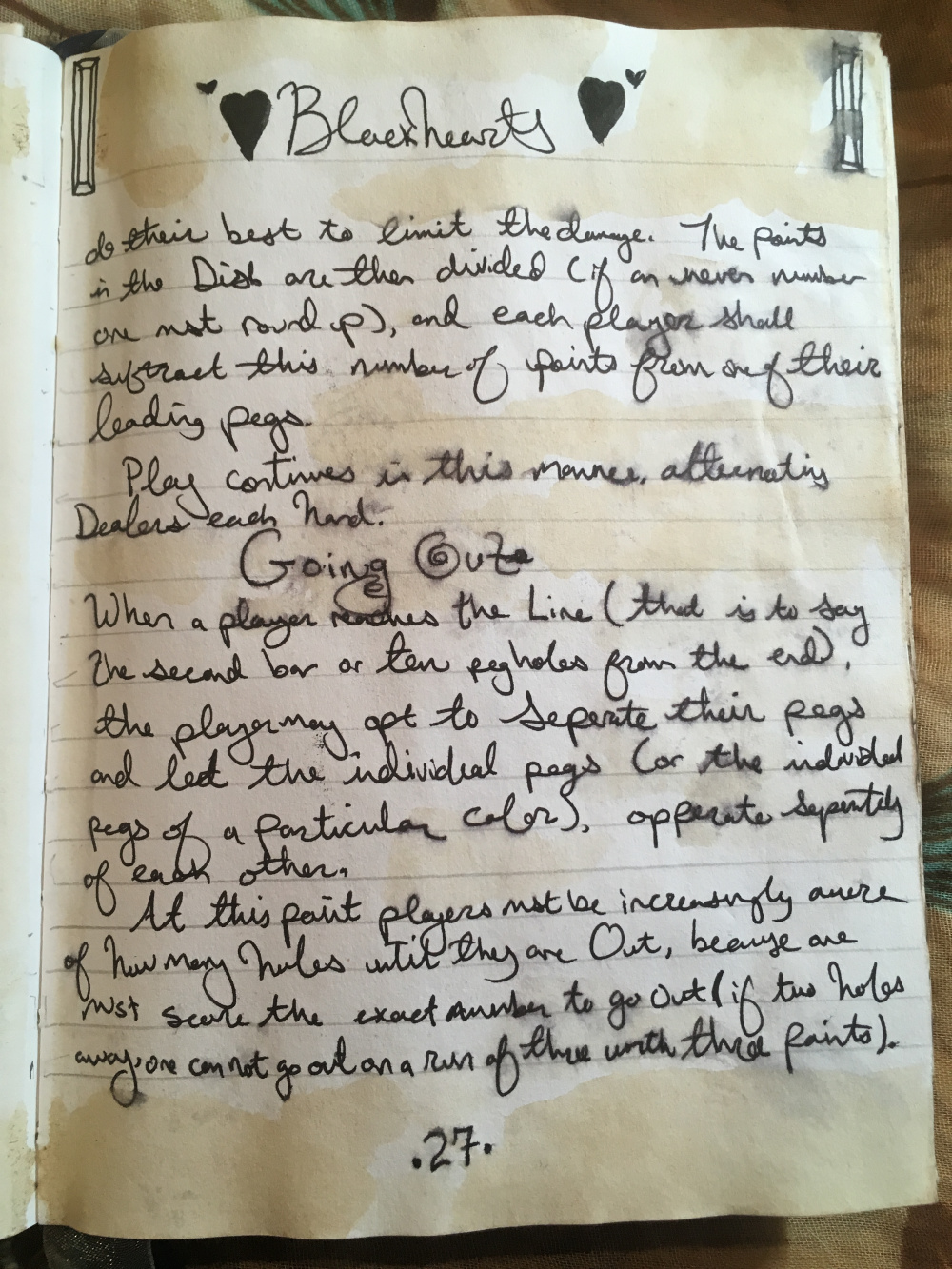We have made it the final section of Blackhearts rules. This is an Accomplishment.

Pages 24 and 25 of the Historica

Page 24 shows “the Suits of a traditional Lillianian deck.” Of course, since the conquering of what was once known as Lilliana by the Willowellans, such decks fell out of favor except amongst the Loyalists (and of course, it would be very suspect to own and especially use such a traitorous object). The suits are (though the drawing is in black and white) brown acorns, and brown pinecones, and green boughs, and green cups.

We left off with our Blackhearts rules on page 23 (It is considered gauche, embarrassing and unbecoming to scramble for points. There is a certain amount of restraint and sportsmanship, and –) and continue to page 25, which is transcribed here:
and discretion in very large hands that should be exercised and employed. It is considered proper to cease counting if the scoring of the hand has become particularly unreasonable.
After both players hands have been counted, the Dish must be addressed.
The Dealer has predominate control of counting the Dish, though both players may give their input. The Dish is counted in the same way as the hands and the players may try to make groupings in such a way so as to minimize the points the Dish earns. However, one must not simply disregard possible points, but must make an honest effort to give the Dish it’s due — though certainly they may —

Pages 26 and 27 of the Historica

Page 26 shows a card from a TwentyFirst deck, the Pixie Card.

Page 27 of the Historica continues the rules of Blackhearts where we left off on page 25 (However, one must not simply disregard possible points, but must make an honest effort to give the Dish it’s due — though certainly they may –) and continues thusly:
Do their best to limit the damage. The points in the Dish are then divided (if an uneven number one must round up), and each player shall subtract this number of points from their leading pegs. Play continues in this manner, alternating Dealers each hand.
Going Out
When a player reaches the Line (that is to say the second bar or ten peg holes from the end), the player may opt to Separate their pegs and let the individual pegs (or the individual pegs of a particular color) operate separately of each other.
At this point players must be increasingly aware of how many holes until they are Out, because one must score the exact number to go Out (if two holes away, one can not go out on a run of three worth three points).

Pages 28 and 29 of the Historica

“A clear quartz finding pendulum,” used for located missing objects, persons or places, most accurately used by Seers and Witches, though some without these skills or pedigrees have found luck in Finding with such a pendulum anyway.

Page 29, transcribed below:
In the Carding stage, if one can not take a point (for example another peg is occupying the hole), the point is given up.
To get around the rule of exact Outing, one may count only some of their points in the Counting stage. — If one has a hand wort, for example, twenty points but has only two holes remaining til Out, they are permitted to lay out their hands in such a way as to group the cards such that the appropriate points are available to them and disregard other points in other card groupings However one may NOT choose to only count some points in a grouping but must rather create a grouping worth ONLY the points they need.
In the example, two points of a pair may–

Pages 30+31

A Seeing Stone, also known as a Seeing Object or simply an Object, is a small mirrored marble used for observing when one is not physically present. Often employed for spying and various subterfuge.

Continuing from “In the example, two points of a pair may–” the rules of Blackhearts are transcribed as follows:
NOT be counted if part of a run, but if grouped separately, may be. The player to get all of his pegs Out first is the Winner.
However
Once a player has a peg out (or several) this peg may still be called back by Subtraction of the Dish, also known as invoking the Rule of the Dish. This is even true if the player has all of their pegs out Unless they get all of their pegs out in one hand.
This callback can occur up to three times. If the second player can not surpass the other in this time (while also subject to being called back), the first player wins.
The player at the end however, may choose to cease their quarrel with each other and focus on beating the Dish if it seems the Dish —

Pages 32 and 33 of the Historica
\
A Kiss Locket. These come in many shapes and styles, but all are tokens of affection between lovers. Kiss Lockets, as the name suggest are lockets which are filled with kisses (usually three) from a lover and worn about the neck. Usually they are worn always in this state, but they may be opened in times of need so the wearer may receive the kisses in spirit. The Locket would of course, then need to be refilled with kisses.

The final page of Blackhearts rules, page 33. This concludes the rule and regulations. We remind the reader where we left off on page 31.
The player at the end however, may choose to cease their quarrel with each other and focus on beating the Dish if it seems the Dish —
Page 33 is transcribed below:
is going to prevent the two from finishing before the third call back. In this scenario, the players can wait for each other, throwing points in the Counting stage by making unprofitable groupings, or in the Carding stage by setting up the other player for Last Card, pairs, etc. If both players manage to get their last pegs out together in one hand the game is over. The Dish does not get counted in this scenario and is considered Beaten. Both players are considered to have won against the Dish. This is considered an honorable way to finish a game of Blackhearts, an[d] if it is possible it is the gentlemanly thing to aim for.
Thus conclude the rules of Blackhearts. One can see why it was a favorite of the Master of Lands, and also why it was not so popular with many others!
Advertisements Share this:





